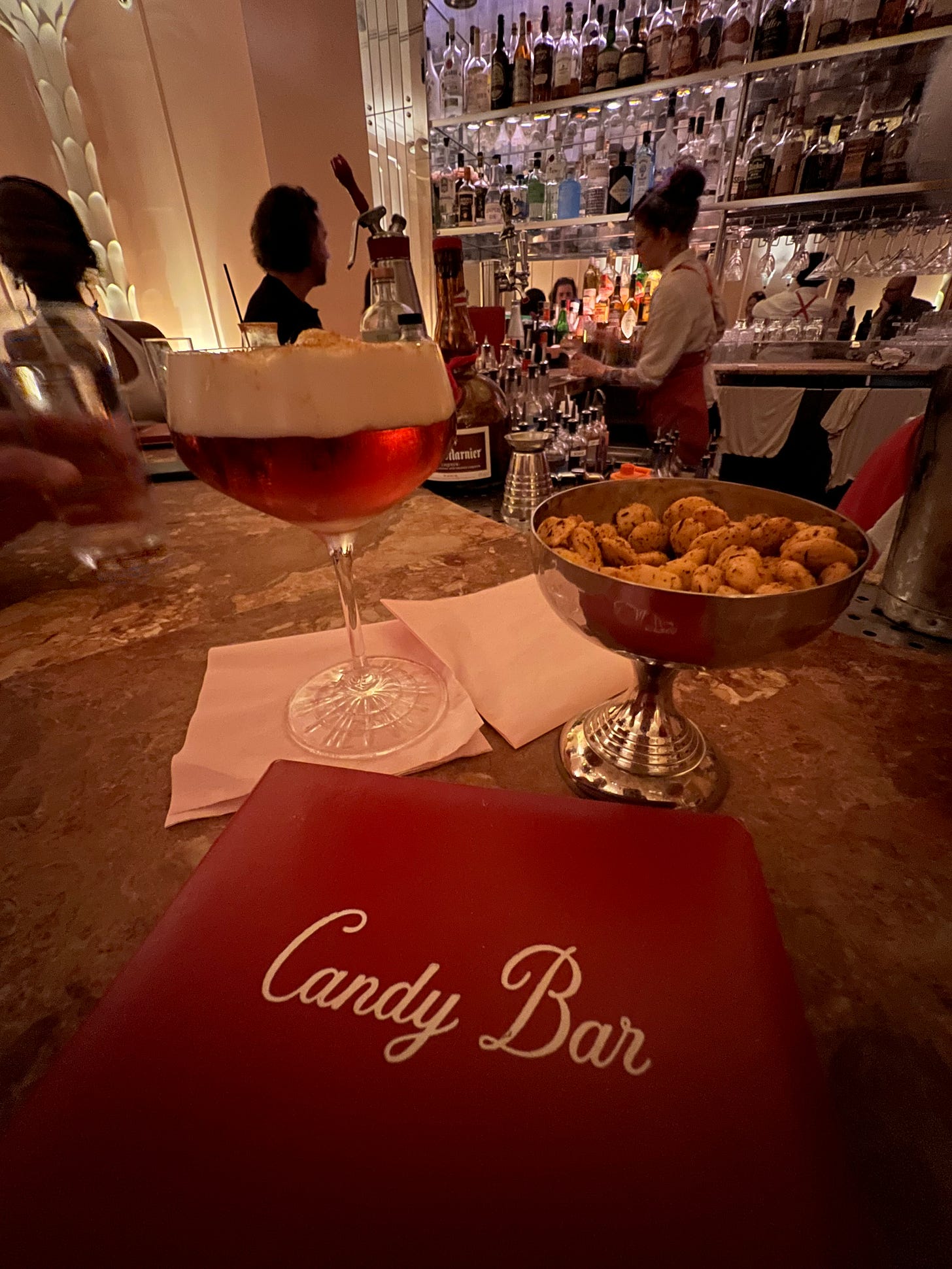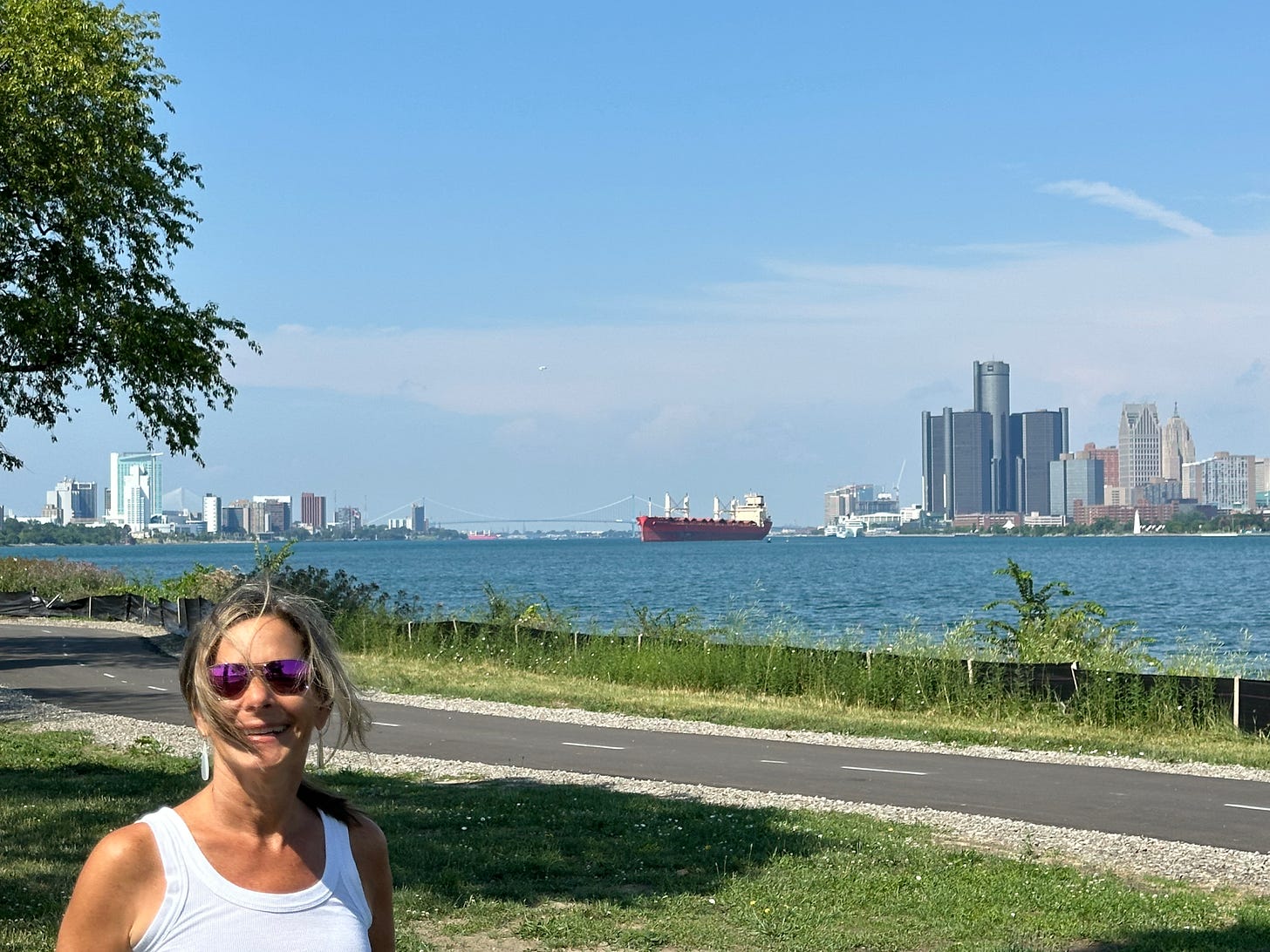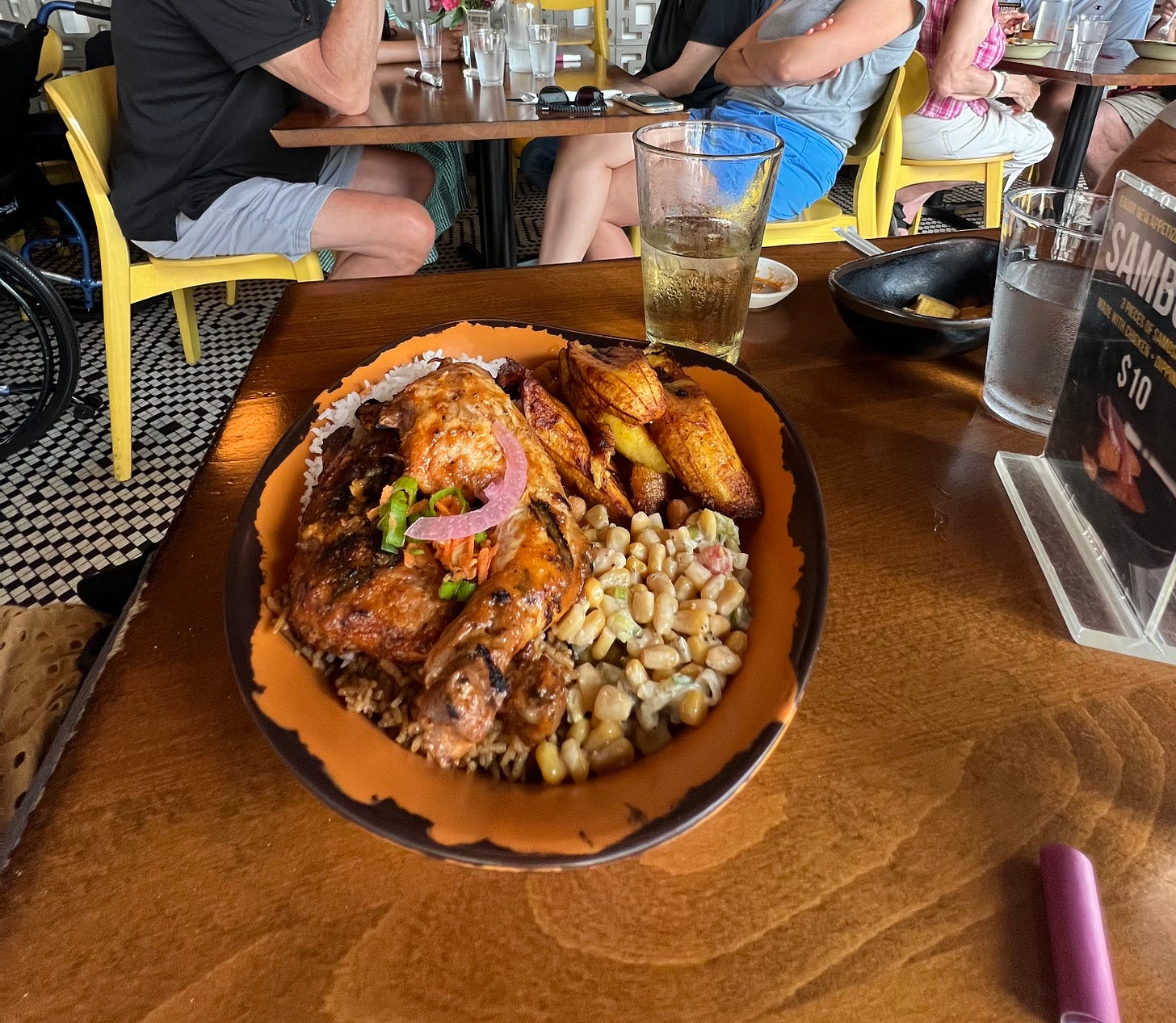Detroit: Car culture, coney islands, cool shoes, and castoffs of capitalism
When is the city's "next time?"
About seven years ago, I saw Instagram posts by some young(er) urbanists from Over-the-Rhine, on a road trip to Detroit. I followed their socials, intrigued. One of my last visits to Detroit occurred around fourth grade for an all-class field trip to the Ford Museum, though I’m sure my parents also dragged us there, to ensure we understood the importance of Henry Ford and the Model T.
Fast forward a “few” decades. Whenever someone mentioned Detroit, my ears perked up. You used to work there? You lived there a while back? There’s a great (insert name here) restaurant on the James Beard list of nominees? The mere mention of Detroit snapped my mind to attention.
When would be my time for Detroit? Was it the city’s time for me?
*
Friday morning, Detroit called, finally. Or shall I say, my husband texted. “Let’s do Detroit this weekend.” I needed to get out of town to get out of my head, or I needed to get to Detroit to get out of his.
That evening, we pulled into The Siren Hotel, which occupied an old Wurlitzer building. With its speakeasy vibes Candy Bar bar hidden behind velvet curtains, a Victorian style lounge for coffee and lounging, and a little wine and ice cream bar behind the black and white subway-tiled elevator hallways, there’s a sense of the unknown that awaits. The weather had cooled slightly. The air was abuzz with Tigers fans who milled about to cheer on the team at Comerica Park. From the rooftop of a local bar, we could see into the stadium if not the game. The Tigers, in first place, couldn’t pull away from the Mariners. The area around the ballpark streamed with people. I pulled Mark along, despite his reminder to slow my gait due to a lingering injury. I wanted him to feel the flow of Detroit I had felt. Perspiring, we marched for blocks, and finally stopped at Eminem’s Mom’s Spaghetti window for a late-night Chinese carryout carton box of spaghetti meatballs.
Later, when I texted my son about the stopover, I was quick point out, the meatballs were meh.
The evening ended at the Candy Bar. With its reds, pinks, and slightly purplish plush banquettes, bar stools, and walls, one easily imagined feeling plopped into the best version of a Willy Wonka factory—for adults and cocktails. Mark drank his Negroni, made also with Negroni foam on top. I sipped on a lovely deeply-pink French rose, content. Thoughts of my injuries were slipping away.
*
We’re not sleepers. It’s one of the reasons why we don’t travel well with others. Our children know this, leave the keys on the table if we’re staying with them, and leave us to our own morning devices. The day stood wide open. Mark suggested a walk to Eastern Market. My stomach grumbled, a side effect from pain meds. I needed food. A little Greek corner shop, Mitsos, whipped up a some sickening sweet coffee and breakfast gyros. While Greektown didn’t make our acquaintance, we later learned later the Greeks immigrants were first to set up coney dog stands (hence the term coney islands), to feed the working masses at breweries and car manufacturing plants.
Eastern Market was a lively mish-mash of produce, pastry, clothing, plants, and miscellany vendors, contained within several hi-roofed market sheds. Tables spilled over outside of the sheds too, while warehouses for everything from soup to literal nuts took up space in surrounding blocks.
Our feet and a few Ubers took us out to Belle Island. We could have biked there from downtown, but injuries would have prevented that. Our first Uber driver, so excited to tell us about the Heidelberg Project (more later), nearly missed the exit to Belle Island. We didn’t have specific plans, but I’m a water girl. Cities I visit always include a water stop. Belle Island sits between two branches of the Detroit River (which connects Lake St. Clair and Lake Erie, and acts as part of international boundary between the United States and Canada).
After walking about a third of the island, we called for an Uber. The next fifteen minutes I sunk into the meandering mind while my husband and our driver partook in a lengthy discourse on the automobile, EVs, and why my husband didn’t plan to buy from Elon Musk. Regardless, every Uber driver here guided a vehicle worthy of admiration, including our final Uber with a real-time rearview mirror. There’s remains a pervasive sense of pride around cars in Detroit. Being a Cleveland girl, I detected Detroit’s scent of a strong work ethic, the wetland floating on the winds off the lake, and truly, what still feels and smells like an immigrant culture in many small ways.
At the Motown Museum, we left disappointed. It’s a small museum. They were booked for the weekend. But nothing contained the smiles of guests who unloaded from buses and vans to be a insert themselves into Motown history.
The day was not a complete loss. We toiled in the hot sun and walked to Baobab Fare. It’s hard to beat a good East African meal, and our dishes did not disappoint. Taking the streetcar back into the city, we rode nearly a full loop to avoid water pelting the windshields. The afternoon filled up quickly with a bit of window shopping, rain avoidance, and a hunt for a Tigers baseball hat.
*
Detroit’s street and building mural art appears everywhere. Market buildings were populated with not only residents and visitors, but depictions of bakers, fishmongers, and other market people. It’s hard not to walk around Detroit and feel the rhythms of the city’s history in their murals, whether the subject was cars, music, protests, or a general good timesness.
The building stock reminded me more of Chicago and Cleveland with wider, open boulevards and its use of marble on facades and exteriors. The Fisher and Guardian buildings are not to be missed, ones I had visited during my previous time. The tiling was a literal coolness to enjoy. Cranes and orange cones dotted the streets. People came out again in numbers for the afternoon Tigers game. It was hard not to imagine the sheer quantities of car money that once passed through Detroit. Like other Rust Belt cities, Detroit eventually suffered from industrial losses, loss of opportunities, and riots that took the lives of 43 people in 1967.
The current Federal administration uses “cities” as pawns in their political games. Cities have long been a beacon of hope for employment, for enjoyment, for bringing together those from other cultures and experiencing their foods and goods. Cities aren’t “better,” but the density to which they bring a level of excitement, a vibe, carries with it a way of being in the wider world.
*
Libraries and bookstores also never fail to show themselves to me. Our dinner for the evening took us near (Vespers) Books and Wine, a thriving wine bar with an eclectic menu and a cookbook collection to sell off their shelves. Would Something Italian ever make it on their shelves? Maybe. While we had passed the Main Library, built along Woodward, on the streetcar route, the smaller, quaint library, The Skillman Library, contained the National Automotive History Collection, boasted of a long ago “Newspaper Room.”
Before dressing for dinner, we stopped at the Greenwich Time Pub, around for 70 years and presumably still run by the original owner’s daughter. There we watched the Tigers swept away by the Mariners once more.
Dinner shone too, in the out of the way restaurant, Barda, snuggled into a shaded urban park. We opted for an outside table despite the heat. Tapas plates arrived loaded with scallops, peaches and burrata, peruvian potatoes, and another negroni for Mark. He returned to books and wine after our dinner for a technology of the cocktail purchase.
The remainder of the evening passed with mostly people watching on the sidewalk cafe of the hotel. Beneath the monorail (people mover), and along the path of dejected Tigers fans who didn’t seem too disappointed, guests came and left the Candy Bar, and also patronized the vinyl bar next door. The mixed crowd hummed along the walkways, content to join the festivities wherever they took them. We passed on the soft serve window and the grilled cheese walk-up window, (apparently walk up food windows are the rage in downtown) and ended with a drip of scotch.
*
Morning took us along Detroit’s Riverwalk which runs about 5 1/2 miles from the famous Ambassador Bridge taking drivers to and from Canada, to the entrance bridge to Belle Isle. Another morning of searing sun rebounding off the river’s rises. In need of coffee, our final city stop was Mad Cap coffee, near the Shinola Hotel. Taking a cue from our earlier Uber driver, we packed up and drove off to Heidelberg Project, a street project undertaken in the 1980s by Tyree Guyton, an artist who wanted to “beautify” and also make a statement about land occupied by vacant homes and bulldozed. The first rule of thumb for any city is to NEVER demolish your housing stock. The artist painted houses, decorated clocks to signify the dispensation of time, and accumulated collections of luggage, grocery carts, shoes, as a statement about the chaos that capitalism causes in our lives. I think he nailed it.



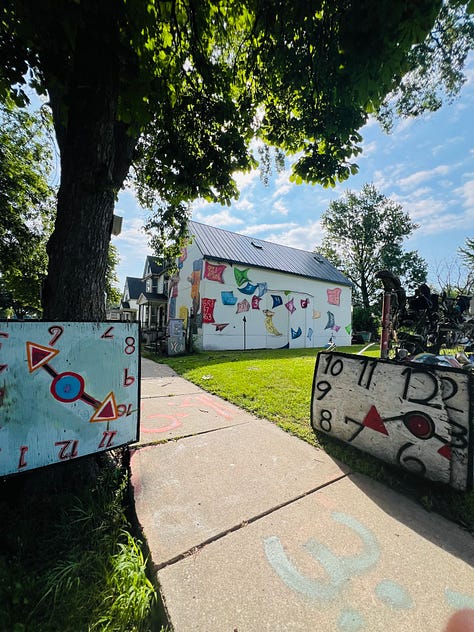
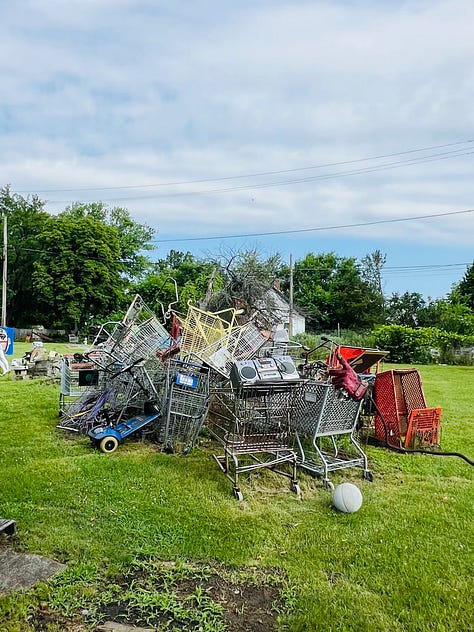
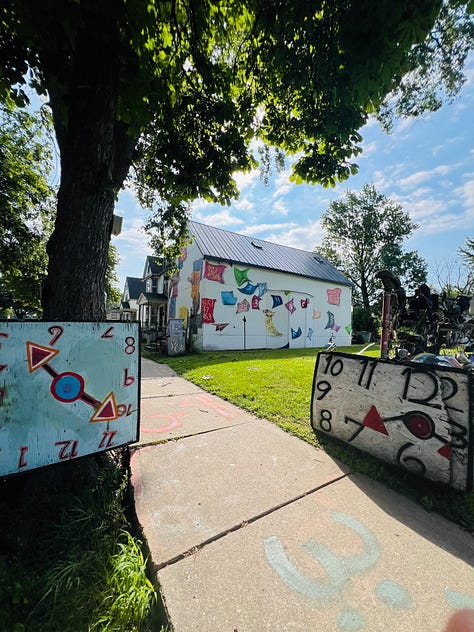
With terrarium plants from Eastern Market still on Mark’s mind, we landed there once more. I loaded up on cherries, Mark left empty-handed. Until…Detroit has a long history of work shoes. There’s a booth where an older gentleman posts up to repair work boots for four months out of the year, and moves to Wisconsin and other upper Midwest states. Down the aisle from him, a worker-owned shoe startup (from 2015), Pingree, makes their own shoes from leather castoffs of new car upholstery. I’m a sucker for a good shoe story. Mark and I each bought a pair, as our anniversary-birthday-Christmas presents for the year. The handsewn shoes arrive in August.


Before loading the car with our cherries take, a stop at Zeff’s was in order. For coneys of course. Coney culture is real here. They take it seriously. Even when Mark and I were detoured to reach I-75, driving down a long stretch behind the Ford plant, we still discovered a lone coney “island” restaurant. At Zeff’s, I ordered the Chicago-style, Mark went straight for the original style. Their beef chili atop the dog was better than what we typically find in Cincinnati.
Quoting Mayor John Pappas in the movie, City Hall, (played by Al Pacino), pontificates, There was a palace that was a city. It was a PALACE! It was a PALACE and it CAN BE A PALACE AGAIN! A PALACE, in which there is no king or queen, or dukes or earls or princes, but subjects all: subjects beholden to each other, to make a better place to live. Is that too much to ask?
Cities are meant for struggling. By this I mean, meant for mental struggling. How do we interact with those of other dispositions, wealth stratums, cultures, faiths, political leanings. It’s where the greatest of debates take place. And sometimes, the greatest of losses.
What’s the message here? We’re told “cities are dangerous.” Those who live outside of them, and deride them, often are the same ones who randomly text us for dinner or cocktail suggestions, or buy up properties for Airbnbs. Cities are a place of learning from the past. What went right? What went wrong? What can we do better next time? When is the next time?
For the city, it’s clear. Food. Shoes. Successful sports teams. My next time is soon. Detroit’s next time is now.
Have you ever been?





